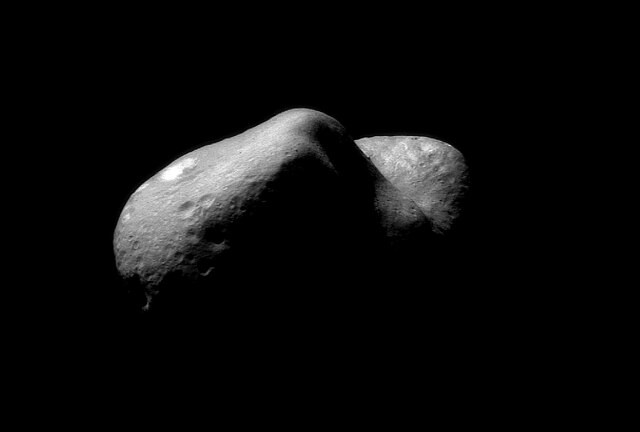
(Photo : Wikimedia Commons/Asteróide Eros)
A new robot has been designed to explore zero-gravity environments and small celestial bodies. The three-legged robot explorer is called SpaceHopper.
Meet SpaceHopper
SpaceHopper could aid in overcoming the difficulties of investigating low-gravity environments, including those on moons or asteroids.
Two and a half years ago, the SpaceHopper program was first introduced as a student research project at the Swiss university ETH Zurich. According to a university statement, researchers recently tested the hopping robot in a simulated zero-gravity environment during a European Space Agency parabolic flight.
Each corner of the robot's triangle body has an articulated leg. With a knee and a hip joint on each of these three legs, the robot can kick off from a surface, travel through space, and regulate its landing inside a predetermined area. The purpose of SpaceHopper is to investigate comparatively small celestial bodies like asteroids and moons where there's little to no gravity.
"[Asteroids] are thought to contain valuable mineral resources that could be of use to humankind in the future," researchers said. "The exploration of these bodies could also give us insights into our universe's formation."
It can be difficult to explore these kinds of celestial bodies, though. In an environment with nearly zero gravity, there is essentially no traction between a spaceship's wheels and the terrain it drives across. If there is any atmosphere, it is not enough for a spacecraft to fly through. For this reason, SpaceHopper moves sideways and upwards by making quick hops.
Thanks to the recent parabolic flight, the researchers were able to model the low-gravity environment in which SpaceHopper would eventually be deployed. In a video recorded during the trip, SpaceHopper can be seen kicking its three legs in unison to maintain lift over thirty instances of zero gravity, lasting roughly 20 to 25 seconds each.
"The experiments were very successful. We were able to show that the robot can use its legs to reposition itself and jump in a certain direction," the researchers said in the video. "Overall, it was very successful."
ALSO READ: Massive Asteroid About the Size of 69 American Alligators Will Pass by Earth Tuesday, NASA Warns
Asteroid Exploration
In related news, Japan wants to rename the space rock 2001 CC21, which is the subject of its Hayabusa2 space probe. JAXA, Japan's space agency, encouraged space enthusiasts to share their ideas.
The enormous space rock resembles the Golden Gate Bridge in scale. JAXA has some standards even though it welcomes comments from the general public.
First and foremost, the name ought to be "non-offensive" and no more than 16 characters. Ultimately, it should be a better name than 2001 CC21.
The campaign ends on May 9. JAXA plans to launch its Hayabusa2 space probe in July 2026 and pass this stony, 1,300 - 1,800 foot-long near-Earth asteroid.
Asteroid 162173 Ryugu, named after a mysterious underwater "Dragon Palace" from Japanese folklore; asteroid 101955 Bennu, named after an Egyptian bird; and many other asteroids orbiting our solar system will be joined by the chosen name.
Every 383.1 days, or 1.05 years, asteroids like 2001 CC21 complete one orbit around the sun, somewhat longer than Earth's. NASA's science definition team has categorized the space rock as a "near-Earth object" because of its distance. Still, it never gets closer to Earth's orbit than 0.08 astronomical units, or 7,436,465 miles.
RELATED ARTICLE: NASA's DART Spacecraft Worked! Asteroid Killer Changed the Harmless Space Rock's Orbit More Than Expected
Check out more news and information on Space in Science Times.














